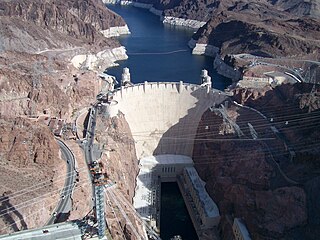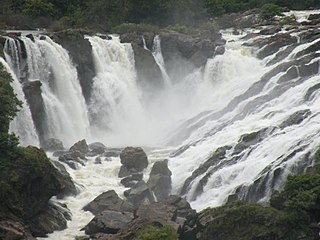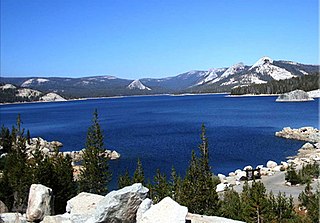
A power station, also referred to as a power plant and sometimes generating station or generating plant, is an industrial facility for the generation of electric power. Power stations are generally connected to an electrical grid.

The Ludington Pumped Storage Plant is a hydroelectric plant and reservoir in Ludington, Michigan. It was built between 1969 and 1973 at a cost of $315 million and is owned jointly by Consumers Energy and DTE Energy and operated by Consumers Energy. At the time of its construction, it was the largest pumped storage hydroelectric facility in the world.

Pumped-storage hydroelectricity (PSH), or pumped hydroelectric energy storage (PHES), is a type of hydroelectric energy storage used by electric power systems for load balancing. The method stores energy in the form of gravitational potential energy of water, pumped from a lower elevation reservoir to a higher elevation. Low-cost surplus off-peak electric power is typically used to run the pumps. During periods of high electrical demand, the stored water is released through turbines to produce electric power. Although the losses of the pumping process make the plant a net consumer of energy overall, the system increases revenue by selling more electricity during periods of peak demand, when electricity prices are highest. If the upper lake collects significant rainfall or is fed by a river then the plant may be a net energy producer in the manner of a traditional hydroelectric plant.

Hydroelectricity, or hydroelectric power, is electricity generated from hydropower. Hydropower supplies one sixth of the world's electricity, almost 4500 TWh in 2020, which is more than all other renewable sources combined and also more than nuclear power. Hydropower can provide large amounts of low-carbon electricity on demand, making it a key element for creating secure and clean electricity supply systems. A hydroelectric power station that has a dam and reservoir is a flexible source, since the amount of electricity produced can be increased or decreased in seconds or minutes in response to varying electricity demand. Once a hydroelectric complex is constructed, it produces no direct waste, and almost always emits considerably less greenhouse gas than fossil fuel-powered energy plants. However, when constructed in lowland rainforest areas, where part of the forest is inundated, substantial amounts of greenhouse gases may be emitted.

The Dinorwig Power Station, known locally as Electric Mountain, or Mynydd Gwefru, is a pumped-storage hydroelectric scheme, near Dinorwig, Llanberis in Snowdonia national park in Gwynedd, north Wales. The scheme can supply a maximum power of 1,728 MW (2,317,000 hp) and has a storage capacity of around 9.1 GWh (33 TJ).

Grid energy storage is a collection of methods used for energy storage on a large scale within an electrical power grid. Electrical energy is stored during times when electricity is plentiful and inexpensive or when demand is low, and later returned to the grid when demand is high, and electricity prices tend to be higher.

Peaking power plants, also known as peaker plants, and occasionally just "peakers", are power plants that generally run only when there is a high demand, known as peak demand, for electricity. Because they supply power only occasionally, the power supplied commands a much higher price per kilowatt hour than base load power. Peak load power plants are dispatched in combination with base load power plants, which supply a dependable and consistent amount of electricity, to meet the minimum demand.

The Kinzua Dam, on the Allegheny River in Warren County, Pennsylvania, is one of the largest dams in the United States east of the Mississippi River. It is located within the Allegheny National Forest.

The Robert Moses Niagara Hydroelectric Power Station is a hydroelectric power station in Lewiston, New York, near Niagara Falls. Owned and operated by the New York Power Authority (NYPA), the plant diverts water from the Niagara River above Niagara Falls and returns the water into the lower portion of the river near Lake Ontario. It uses 13 generators at an installed capacity of 2,525 MW (3,386,000 hp).

Muddy Run Pumped Storage Facility was built by the Philadelphia Electric Company and is a pumped-storage hydroelectric generation facility in Drumore Township, Pennsylvania, United States. When completed in 1968, Muddy Run was the largest pumped-storage facility in the world. Muddy Run has a capacity of 1,071 megawatts. The facility is operated by the Susquehanna Electric Company, a subsidiary of Constellation Energy. Ernest Spey was the superintendent of Conowingo Hydroelectric Dam and the new Muddy Run facility until 1989.

Pennsylvania Route 59 is a 39-mile (63 km) long state highway located in northwest Pennsylvania. The route links Warren to Smethport, terminating at U.S. Route 6 at both ends. PA 59 acts as a northerly bypass to US 6, directly connecting Warren and Smethport while US 6 dips south to serve Kane and Mount Jewett.
The Ingula Pumped Storage Scheme is a pumped-storage power station in the escarpment of the Little Drakensberg range straddling the border of the KwaZulu-Natal and Free State provinces, South Africa. It is about 22 km (14 mi) North-East of Van Reenen.

Hydroelectricity is, as of 2019, the second-largest renewable source of energy in both generation and nominal capacity in the United States. In 2021, hydroelectric power produced 31.5% of the total renewable electricity, and 6.3% of the total U.S. electricity.

The Mingtan Dam is a dam that spans the Shuili River about 4 km (2.5 mi) downstream from the outlet of Sun Moon Lake in central Taiwan with a height of about 61.5 m (202 ft). It forms Mingtan Reservoir which is the lower reservoir for the Mingtan Pumped Storage Hydro Power Plant.

India is 5th globally for installed hydroelectric power capacity. As of 31 March 2020, India's installed utility-scale hydroelectric capacity was 46,000 MW, or 12.3% of its total utility power generation capacity. Additional smaller hydroelectric power units with a total capacity of 4,683 MW have been installed. India's hydroelectric power potential is estimated at 148,700 MW at 60% load factor. In the fiscal year 2019–20, the total hydroelectric power generated in India was 156 TWh with an average capacity factor of 38.71%.

Castaic Power Plant, also known as the Castaic Pumped-Storage Plant, is a seven unit pumped-storage hydroelectric plant, operated by the Los Angeles Department of Water and Power, which provides peak load power from the falling water on the West Branch of the California State Aqueduct. It is a cooperative venture between the LADWP and the Department of Water Resources of the State of California. An agreement between the two organizations was signed on September 2, 1966, for construction of the project.

The Helms Pumped Storage Plant is located 50 mi (80 km) east of Fresno, California in the Sierra Nevada Mountain Range's Sierra National Forest. It is a power station that uses Helms Creek canyon on the North Fork of the Kings River for off-river water storage and the pumped-storage hydroelectric method to generate electricity. After being planned in the early 1970s, construction on the plant began in June 1977 and commercial operations began on 30 June 1984. It has an installed capacity of 1,212 MW and is owned by Pacific Gas and Electric Company.
The Yixing Pumped Storage Power Station is a pumped-storage hydroelectric power station located Yixing city of Jiangsu Province, China. Construction on the power station began in 2003 and the first unit was commissioned in 2007, the last in 2008. The entire project cost US$490 million, of which US$145 million was provided by the World Bank. The power station operates by shifting water between an upper and lower reservoir to generate electricity. The lower reservoir was formed with the existing Huiwu Dam at the foot of Mount Tongguan. The Yixing Upper Reservoir is located atop Mount Tongguan which peaks at 530 metres (1,740 ft) above sea level. During periods of low energy demand, such as at night, water is pumped from Huiwu Lower Reservoir up to the upper reservoir. When energy demand is high, the water is released back down to the lower reservoir but the pump turbines that pumped the water up now reverse mode and serve as generators to produce electricity. Water from the nearby Huangtong River can also be pumped into the lower reservoir to augment storage. The process is repeated as necessary and the plant serves as a peaking power plant. The power station is operated by East China Yixing Pumped Storage Co Ltd.
The Qingyuan Pumped Storage Power Station is a 1,280 MW pumped-storage hydroelectric power station about 20 km (12 mi) northwest of Qingyuan in Qingxin District, Guangdong Province, China. Construction on the project began in October 2008. The upper reservoir began impounding water in March 2013 and the first generator and all four generators were commissioned by 30 November 2015.

The Imaichi Pumped Storage Power Station is a large pumped-storage hydroelectric power station in Tochigi Prefecture, Japan. With a total installed capacity of 1,050 megawatts (1,410,000 hp), it is one of the largest pumped-storage power stations in Japan. The facility is run by the Tokyo Electric Power Company (TEPCO). The power plant started operation in July 1988 with a capacity of 350 MW. The other two units entered operation in December 1991. The plant is one of the many large scale pure pumped-storage plants built in Japan since the 1970s to compensate for the increased penetration of base-load nuclear power and peak load from cooling and air-conditioning.



















